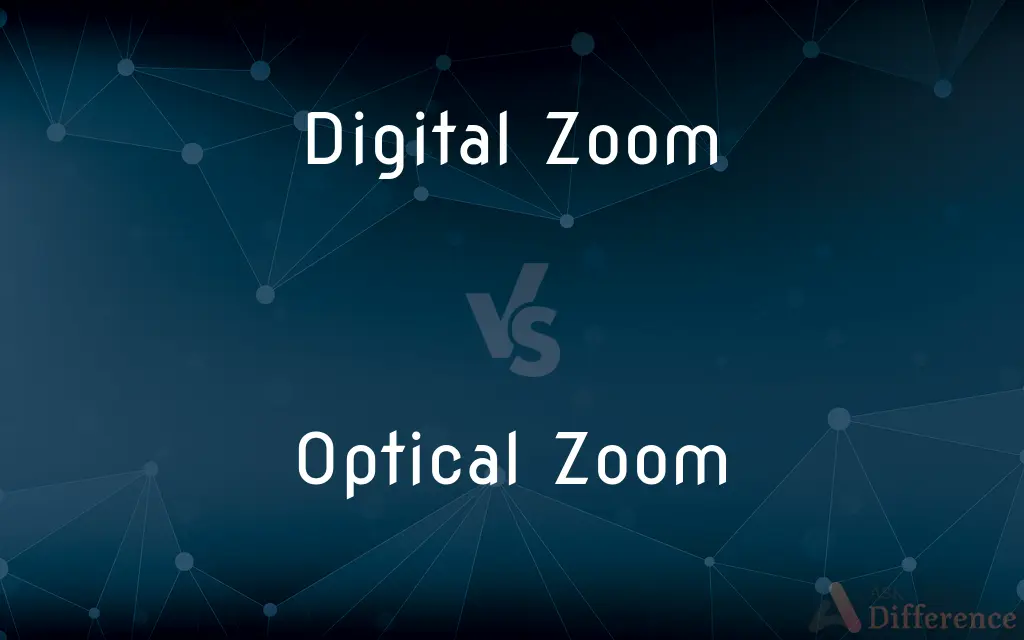Digital Zoom vs. Optical Zoom — What's the Difference?
By Tayyaba Rehman & Urooj Arif — Published on February 15, 2024
Digital Zoom enlarges the image using software, often reducing quality. Optical Zoom uses the camera's lens to bring the subject closer, preserving image quality.

Difference Between Digital Zoom and Optical Zoom
Table of Contents
ADVERTISEMENT
Key Differences
Digital Zoom and Optical Zoom are two technologies used in cameras and smartphones to bring distant subjects closer. Optical Zoom involves the physical movement of lens elements to magnify the subject, maintaining the image's integrity and resolution. It allows photographers to zoom in on a subject without compromising image quality, making it ideal for capturing detailed photographs from a distance.
Digital Zoom, on the other hand, works by cropping the central part of the image and enlarging it digitally, which can lead to a reduction in image quality. This process is akin to enlarging a portion of a photo in an image editing program. While digital zoom offers the convenience of zooming in post-capture and can be useful in situations where optical zoom is not available, it often results in pixelation and a loss of detail, especially when used extensively.
One of the key differences between the two zoom types is their impact on image quality. Optical Zoom maintains the clarity and resolution of the image because it relies on the camera's optics. Digital Zoom, by increasing the size of pixels, can degrade the photo's quality, making it less suitable for applications where detail is crucial.
In terms of usability, Optical Zoom is generally preferred by professional photographers and those seeking high-quality images. Digital Zoom is more commonly found in devices where space constraints limit the inclusion of complex optical systems, such as smartphones and compact cameras.
In summary, while both Digital and Optical Zoom serve the purpose of bringing distant subjects closer, they do so in fundamentally different ways, with Optical Zoom providing superior image quality due to its reliance on the camera's lens system, and Digital Zoom offering a software-based solution that may compromise image detail.
ADVERTISEMENT
Comparison Chart
Mechanism
Enlarges the image digitally
Uses lens movement to magnify the subject
Image Quality
Can decrease due to pixel enlargement
Maintains high image quality
Commonly Found In
Smartphones, compact cameras
DSLR, mirrorless, and higher-end cameras
Versatility
Limited by image resolution
More versatile with variable focal lengths
Cost
Generally lower, as it's software-based
Higher due to the complexity of lens systems
Compare with Definitions
Digital Zoom
Can lead to reduced image quality and pixelation.
Overusing digital zoom resulted in a grainy and pixelated picture.
Optical Zoom
Maintains image resolution and detail.
Optical zoom ensured my photos remained sharp and clear.
Digital Zoom
Software-based enlargement of an image's central portion.
I used digital zoom to get a closer look at the bird in the photo.
Optical Zoom
Offers variable focal lengths for versatility.
I switched focal lengths using optical zoom to frame my shot.
Digital Zoom
Does not require moving lens elements.
Digital zoom works without any physical adjustments to the camera.
Optical Zoom
Involves physical movement of lens elements.
The lens extended as I adjusted the optical zoom.
Digital Zoom
Offers flexibility in devices with fixed lenses.
My smartphone's digital zoom helps me capture distant subjects.
Optical Zoom
Uses lens optics to bring the subject closer without losing quality.
The camera's optical zoom preserved the details of the landscape.
Digital Zoom
Useful for minor adjustments when optical zoom isn't available.
I rely on digital zoom for quick close-ups when shooting with my phone.
Optical Zoom
Preferred for high-quality photography and videography.
Professional photographers rely on optical zoom for clarity.
Common Curiosities
Which zoom is better for professional photography, digital or optical?
Optical zoom is preferred for its quality preservation.
Do all cameras have both digital and optical zoom?
Not all; many professional cameras emphasize optical zoom, while smartphones often rely on digital.
Is digital zoom the same as cropping a photo?
Essentially, yes; it's similar to cropping and enlarging a portion of the image.
Can digital zoom be used without quality loss?
Minimal use may not noticeably affect quality, but extensive use often reduces clarity.
Can I disable digital zoom on my device?
Many devices allow you to limit or disable digital zoom in settings.
Does using optical zoom reduce the photo's resolution?
No, it maintains the original resolution by using the lens to magnify the image.
Does optical zoom affect focusing speed?
It can, especially in lower light conditions or at maximum zoom levels.
Can I improve digital zoom quality in post-processing?
Software can enhance images to some degree, but it can't fully restore lost detail.
How does optical zoom affect aperture and exposure?
Changing optical zoom can alter the aperture, impacting exposure and depth of field.
Can optical zoom change the photo's perspective?
Yes, changing focal lengths can alter perspective and background compression.
Why do smartphones primarily use digital zoom?
Due to space constraints and the fixed lens design in most smartphones.
Is there a limit to how much optical zoom can magnify?
Yes, it's limited by the lens design and focal length range.
How do I know if my camera is using digital or optical zoom?
Cameras often indicate when digital zoom takes over after the optical limit is reached.
Are there cameras that offer both high-quality digital and optical zoom?
Some high-end cameras and smartphones offer advanced digital zoom technologies that minimize quality loss.
How does zoom impact battery life in cameras and smartphones?
Optical zoom can consume more power due to physical lens movement, whereas digital zoom's power impact is minimal.
Share Your Discovery

Previous Comparison
Skim Milk vs. Whole Milk
Next Comparison
Free-Range Eggs vs. Organic EggsAuthor Spotlight
Written by
Tayyaba RehmanTayyaba Rehman is a distinguished writer, currently serving as a primary contributor to askdifference.com. As a researcher in semantics and etymology, Tayyaba's passion for the complexity of languages and their distinctions has found a perfect home on the platform. Tayyaba delves into the intricacies of language, distinguishing between commonly confused words and phrases, thereby providing clarity for readers worldwide.
Co-written by
Urooj ArifUrooj is a skilled content writer at Ask Difference, known for her exceptional ability to simplify complex topics into engaging and informative content. With a passion for research and a flair for clear, concise writing, she consistently delivers articles that resonate with our diverse audience.
















































